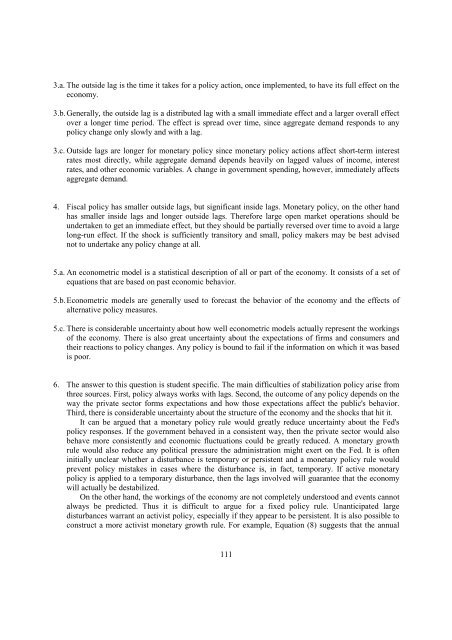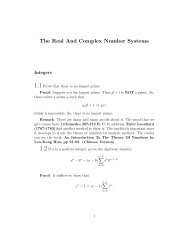Fiscal and monetary policy lags ⢠Automatic stabilizers ...
Fiscal and monetary policy lags ⢠Automatic stabilizers ...
Fiscal and monetary policy lags ⢠Automatic stabilizers ...
You also want an ePaper? Increase the reach of your titles
YUMPU automatically turns print PDFs into web optimized ePapers that Google loves.
3.a. The outside lag is the time it takes for a <strong>policy</strong> action, once implemented, to have its full effect on theeconomy.3.b. Generally, the outside lag is a distributed lag with a small immediate effect <strong>and</strong> a larger overall effectover a longer time period. The effect is spread over time, since aggregate dem<strong>and</strong> responds to any<strong>policy</strong> change only slowly <strong>and</strong> with a lag.3.c. Outside <strong>lags</strong> are longer for <strong>monetary</strong> <strong>policy</strong> since <strong>monetary</strong> <strong>policy</strong> actions affect short-term interestrates most directly, while aggregate dem<strong>and</strong> depends heavily on lagged values of income, interestrates, <strong>and</strong> other economic variables. A change in government spending, however, immediately affectsaggregate dem<strong>and</strong>.4. <strong>Fiscal</strong> <strong>policy</strong> has smaller outside <strong>lags</strong>, but significant inside <strong>lags</strong>. Monetary <strong>policy</strong>, on the other h<strong>and</strong>has smaller inside <strong>lags</strong> <strong>and</strong> longer outside <strong>lags</strong>. Therefore large open market operations should beundertaken to get an immediate effect, but they should be partially reversed over time to avoid a largelong-run effect. If the shock is sufficiently transitory <strong>and</strong> small, <strong>policy</strong> makers may be best advisednot to undertake any <strong>policy</strong> change at all.5.a. An econometric model is a statistical description of all or part of the economy. It consists of a set ofequations that are based on past economic behavior.5.b. Econometric models are generally used to forecast the behavior of the economy <strong>and</strong> the effects ofalternative <strong>policy</strong> measures.5.c. There is considerable uncertainty about how well econometric models actually represent the workingsof the economy. There is also great uncertainty about the expectations of firms <strong>and</strong> consumers <strong>and</strong>their reactions to <strong>policy</strong> changes. Any <strong>policy</strong> is bound to fail if the information on which it was basedis poor.6. The answer to this question is student specific. The main difficulties of stabilization <strong>policy</strong> arise fromthree sources. First, <strong>policy</strong> always works with <strong>lags</strong>. Second, the outcome of any <strong>policy</strong> depends on theway the private sector forms expectations <strong>and</strong> how those expectations affect the public's behavior.Third, there is considerable uncertainty about the structure of the economy <strong>and</strong> the shocks that hit it.It can be argued that a <strong>monetary</strong> <strong>policy</strong> rule would greatly reduce uncertainty about the Fed's<strong>policy</strong> responses. If the government behaved in a consistent way, then the private sector would alsobehave more consistently <strong>and</strong> economic fluctuations could be greatly reduced. A <strong>monetary</strong> growthrule would also reduce any political pressure the administration might exert on the Fed. It is ofteninitially unclear whether a disturbance is temporary or persistent <strong>and</strong> a <strong>monetary</strong> <strong>policy</strong> rule wouldprevent <strong>policy</strong> mistakes in cases where the disturbance is, in fact, temporary. If active <strong>monetary</strong><strong>policy</strong> is applied to a temporary disturbance, then the <strong>lags</strong> involved will guarantee that the economywill actually be destabilized.On the other h<strong>and</strong>, the workings of the economy are not completely understood <strong>and</strong> events cannotalways be predicted. Thus it is difficult to argue for a fixed <strong>policy</strong> rule. Unanticipated largedisturbances warrant an activist <strong>policy</strong>, especially if they appear to be persistent. It is also possible toconstruct a more activist <strong>monetary</strong> growth rule. For example, Equation (8) suggests that the annual111
















